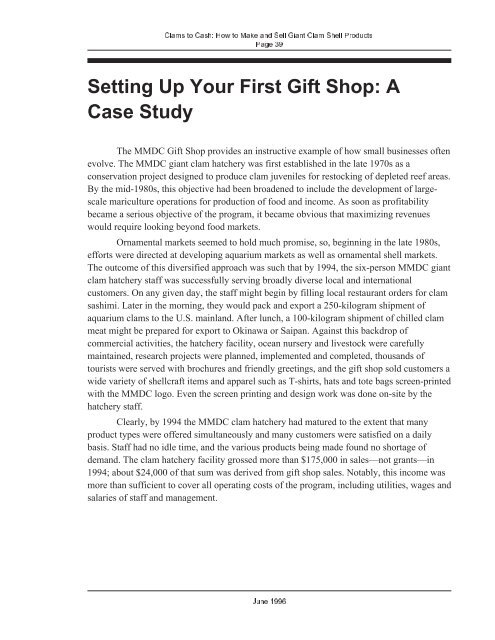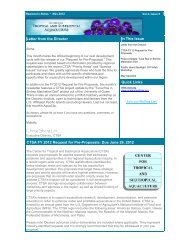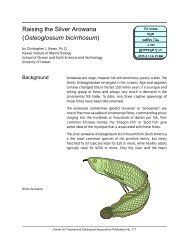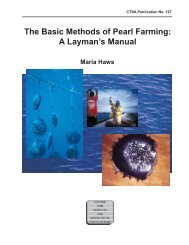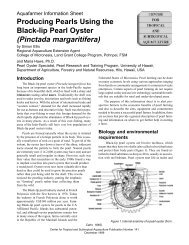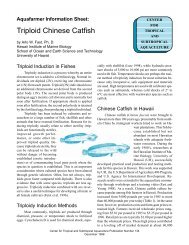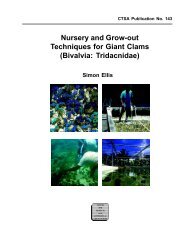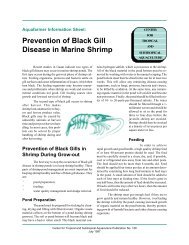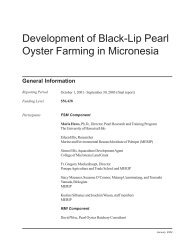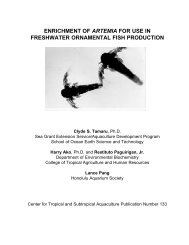<strong><strong>Clam</strong>s</strong> <strong>to</strong> <strong>Cash</strong>: <strong>How</strong> <strong>to</strong> <strong>Make</strong> <strong>and</strong> <strong>Sell</strong> <strong>Giant</strong> <strong>Clam</strong> <strong>Shell</strong> ProductsPage 39Setting Up Your First Gift Shop: ACase StudyThe MMDC Gift Shop provides an instructive example of how small businesses oftenevolve. The MMDC giant clam hatchery was first established in the late 1970s as aconservation project designed <strong>to</strong> produce clam juveniles for res<strong>to</strong>cking of depleted reef areas.By the mid-1980s, this objective had been broadened <strong>to</strong> include the development of largescalemariculture operations for production of food <strong>and</strong> income. As soon as profitabilitybecame a serious objective of the program, it became obvious that maximizing revenueswould require looking beyond food markets.Ornamental markets seemed <strong>to</strong> hold much promise, so, beginning in the late 1980s,efforts were directed at developing aquarium markets as well as ornamental shell markets.The outcome of this diversified approach was such that by 1994, the six-person MMDC giantclam hatchery staff was successfully serving broadly diverse local <strong>and</strong> internationalcus<strong>to</strong>mers. On any given day, the staff might begin by filling local restaurant orders for clamsashimi. Later in the morning, they would pack <strong>and</strong> export a 250-kilogram shipment ofaquarium clams <strong>to</strong> the U.S. mainl<strong>and</strong>. After lunch, a 100-kilogram shipment of chilled clammeat might be prepared for export <strong>to</strong> Okinawa or Saipan. Against this backdrop ofcommercial activities, the hatchery facility, ocean nursery <strong>and</strong> lives<strong>to</strong>ck were carefullymaintained, research projects were planned, implemented <strong>and</strong> completed, thous<strong>and</strong>s of<strong>to</strong>urists were served with brochures <strong>and</strong> friendly greetings, <strong>and</strong> the gift shop sold cus<strong>to</strong>mers awide variety of shellcraft items <strong>and</strong> apparel such as T-shirts, hats <strong>and</strong> <strong>to</strong>te bags screen-printedwith the MMDC logo. Even the screen printing <strong>and</strong> design work was done on-site by thehatchery staff.Clearly, by 1994 the MMDC clam hatchery had matured <strong>to</strong> the extent that manyproduct types were offered simultaneously <strong>and</strong> many cus<strong>to</strong>mers were satisfied on a dailybasis. Staff had no idle time, <strong>and</strong> the various products being made found no shortage ofdem<strong>and</strong>. The clam hatchery facility grossed more than $175,000 in sales—not grants—in1994; about $24,000 of that sum was derived from gift shop sales. Notably, this income wasmore than sufficient <strong>to</strong> cover all operating costs of the program, including utilities, wages <strong>and</strong>salaries of staff <strong>and</strong> management.June 1996
<strong><strong>Clam</strong>s</strong> <strong>to</strong> <strong>Cash</strong>: <strong>How</strong> <strong>to</strong> <strong>Make</strong> <strong>and</strong> <strong>Sell</strong> <strong>Giant</strong> <strong>Clam</strong> <strong>Shell</strong> ProductsPage 40Surprisingly enough, for more than a decade after the MMDC’s inception, it had nogift shop. During that time, thous<strong>and</strong>s of potential cus<strong>to</strong>mers passed through the facilitywithout having the opportunity <strong>to</strong> buy anything. In retrospect, this was lost opportunity on agr<strong>and</strong> scale. To be fair, the prevailing view in the 1970s <strong>and</strong> early 1980s was that the facilitycould survive <strong>and</strong> prosper on research grants <strong>and</strong> contracts alone. No real need was felt <strong>to</strong>generate revenue internally <strong>and</strong> so no real effort was invested in earning money, apart fromwriting grant proposals. For a time, this approach was acceptable. Eventually, however,unmistakable signs of “donor fatigue” became evident, <strong>and</strong> the facility clearly needed <strong>to</strong>move <strong>to</strong>ward self-sufficiency.A policy breakthrough for the MMDC came in 1987, when the Palau governmentgranted permission <strong>to</strong> begin a fee-based, export marketing program for giant clam products.This required that MMDC establish internal financial controls, produce regular financialreports, <strong>and</strong> subject all financial records <strong>to</strong> independent annual audits.The MMDC Gift Shop itself had very humble origins, a fact that is particularlyrelevant <strong>to</strong> clam farmers <strong>and</strong> hatchery opera<strong>to</strong>rs who have had no retail experience. At first,MMDC’s “gift shop” was literally nothing more than a 4-by-8-foot sheet of plywood laidacross two saw horses! We put clam shells with price tags on <strong>to</strong>p of this makeshift table. Wewere fortunate in having a regular parade of <strong>to</strong>urists passing by the table. When someonewanted <strong>to</strong> buy a shell, one of the hatchery staff would s<strong>to</strong>p what he or she was doing <strong>and</strong>make the sale. Note that this approach involved virtually nothing in the way of startup costs:no expensive capital investment <strong>and</strong> no shop employees.Only after many months <strong>and</strong> about $6,000 in sales did we consider improving the giftshop. We invested about $3,000 in building a small, open-sided, 10-by-20-foot, roofedaddition adjacent <strong>to</strong> the clam hatchery building. Several months <strong>and</strong> thous<strong>and</strong>s of dollars insales later, we added security screen <strong>to</strong> the walls of the shop.Eventually, further income permitted the establishment of $3,000 worth of furtherimprovements, including shelving, a nicely paneled interior of stained wood <strong>and</strong> a beautifulfloor of quarried pink Philippine marble. We then invested about $5,000 more in four largeaquarium tanks with state-of-the-art metal halide <strong>and</strong> actinic lighting. Many cus<strong>to</strong>mers <strong>to</strong>ldus that our aquarium exhibits were the finest they had ever seen; their impact on cus<strong>to</strong>merswas nothing short of extraordinary.Even though the MMDC Gift Shop was small, it was a unique experience forcus<strong>to</strong>mers. Most cus<strong>to</strong>mers had never seen a giant clam before, let alone giant clam shellcraft<strong>and</strong> state-of-the-art coral reef tank displays. All cus<strong>to</strong>mers seemed <strong>to</strong> appreciate the style <strong>and</strong>neatness of the shop.Note that not a penny of debt was incurred in setting up the gift shop or theexpansions <strong>and</strong> improvements. The construction was paid for solely by sales.June 1996


